Understanding Animal Netting: What It Is and Why You Need It
Animal netting is a protective barrier designed to prevent wildlife from entering certain areas, safeguarding gardens, farms, and private properties. This versatile solution can be made from a variety of materials, including synthetic fibers and natural substances, which provide durability and resistance against the elements. Its design generally consists of mesh-like structures that can effectively deter small to medium-sized animals such as deer, rabbits, and birds while allowing sunlight and moisture to reach plants below.
Farmers and gardeners frequently utilize animal netting to protect crops from being foraged or damaged by local wildlife. This safeguarding is essential, particularly in areas where deer and birds can wreak havoc on a harvest. By implementing netting solutions, growers can not only sustain their crops but also boost their overall yield, thereby securing their investment. In residential settings, individuals often adopt animal netting to keep pets safely contained within their yards, simultaneously restricting the access of unwanted animals that may pose a risk to household security or lawn integrity.
The necessity for animal netting transcends mere aesthetic appeal or convenience; it plays a critical role in ensuring the sustainability of gardens and crops. Besides protecting plants, netting serves as an effective deterrent against disease transmission that can occur when wildlife comes into close contact with agricultural or ornamental plants. Additionally, using netting can signify respect for the surrounding ecosystem, maintaining a delicate balance while allowing nature and human habitation to coexist more harmoniously.
Incorporating animal netting into your wildlife protection strategy provides peace of mind and fosters an environment where your landscape can flourish without undue disruption from wild animals. It serves as a pragmatic solution to common challenges faced by gardeners and property owners, ensuring that both plants and pets thrive in a secure environment.
Common Animals That Cause Damage and How to Prevent It

In various environments, certain wildlife species can significantly harm gardens, farms, and properties. Understanding the types of animals that frequently pose a threat is crucial for preventing potential damage. Among the most notorious culprits are deer, which can wreak havoc on landscaping and crops. These large mammals tend to graze on tender shoots and fruit, leaving gardens devastated. To mitigate their impact, gardens can benefit from strategic fencing, but one of the most effective methods is utilizing animal netting. This barrier helps shield valuable plants while allowing sunlight and rain to reach the foliage.
Birds are another group that poses challenges, especially in agricultural settings. Species such as crows, sparrows, and finches often invade farmland, pecking at seeds and fruits as they grow. Similarly, rabbits can cause significant destruction as they nibble on young sprouts and flowers in gardens. These small animals can multiply quickly, further escalating their threat to the aesthetics and function of a property. Implementing animal netting around vulnerable areas not only deters these pests but also protects young plants from destruction during their most critical growth stages.
Raccoons, known for their dexterity and intelligence, are notorious for raiding bins and gardens alike. Their ability to unlock containers and forage through trash means homeowners can face considerable challenges when it comes to maintaining a tidy yard. Utilizing animal netting can effectively hinder raccoons from accessing gardens and crop areas, thereby preserving both the beauty of the space and the resources invested in it. By employing animal netting as a preventative measure, property owners can secure their landscapes against these troublesome wildlife invaders and reduce costs associated with damage repairs.
The Benefits of Using High-Quality Animal Netting
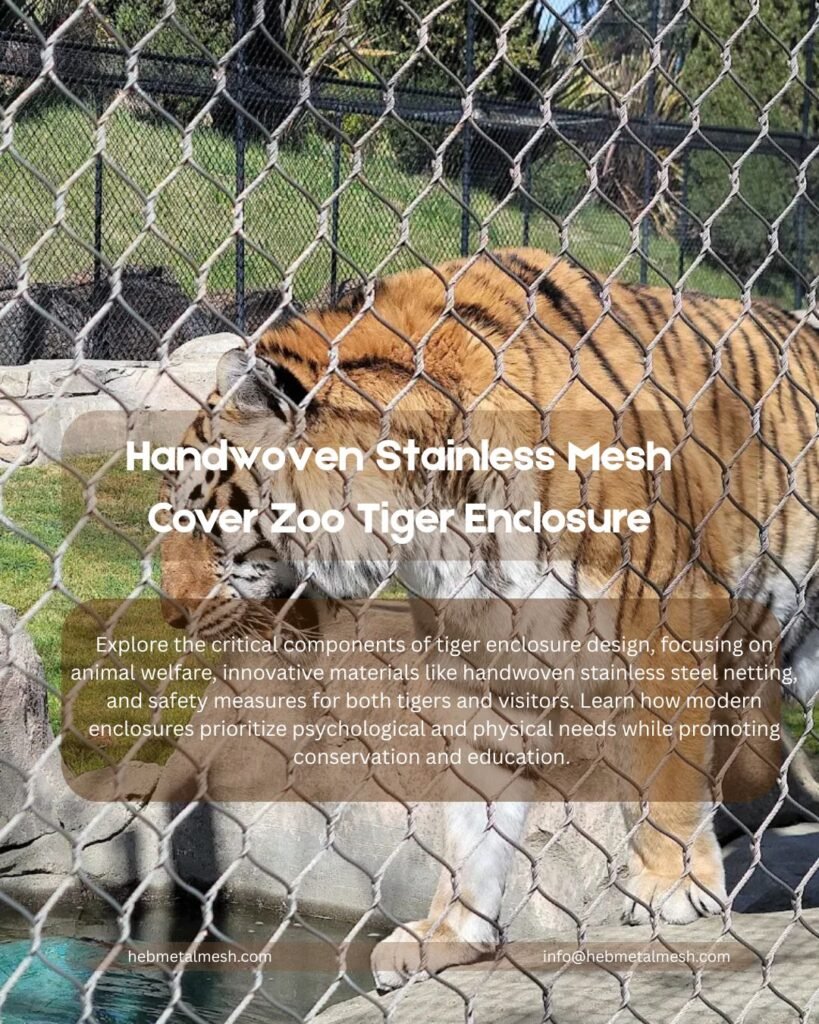
When it comes to wildlife protection, the choice of material plays a crucial role in ensuring effectiveness and durability. High-quality animal netting provides a range of advantages that not only safeguard your outdoor spaces but also save you money in the long run. Unlike low-quality alternatives, which can deteriorate quickly and require frequent replacement, premium animal netting options, such as handwoven stainless steel mesh, offer superior resilience against environmental factors.
Durability is one of the most significant benefits of investing in high-quality animal netting. Premium materials resist wear and tear from harsh weather conditions, strong winds, and UV exposure. Low-quality netting tends to fray or break down over time, leaving your property vulnerable to wildlife. High-quality animal netting, however, remains intact under challenging conditions, providing a reliable barrier for your gardens, crops, or livestock.
Furthermore, effectiveness is greatly enhanced with top-tier animal netting. This type of netting is designed not only to keep unwanted wildlife out but also to accommodate a variety of species, preventing them from damaging your plants or spreading diseases. By investing in high-quality options, you are ensuring that your protective measures are both comprehensive and sustainable.
Long-term savings are another notable advantage. Although the initial cost of premium animal netting may be higher, the benefits far outweigh the expenditures over time. Fewer replacements, minimal maintenance, and the peace of mind that comes from knowing your investment is secure contribute to overall cost savings. In contrast, opting for low-quality netting often leads to recurring expenses and constant worry about its effectiveness. By choosing high-quality animal netting, you take a proactive approach to wildlife protection, gaining reliable results that last for years.
Handwoven Stainless Steel Mesh: The Superior Choice
When it comes to animal netting, handwoven stainless steel mesh stands out as a premium solution for those seeking to protect their property from wildlife intrusion. This exceptional material offers a trifecta of advantages: strength, weather resistance, and aesthetic appeal, making it an ideal choice for not only securing your spaces but also enhancing their overall beauty.
Firstly, the strength of handwoven stainless steel mesh is unparalleled. Unlike traditional netting materials that may sag or deteriorate over time, this robust option is specifically designed to withstand the rigors of the environment. Its durable construction provides an impenetrable barrier, adept at keeping out even the most determined animals. Whether you are protecting gardens, livestock, or landscaping, this type of netting offers assurance and peace of mind against potential threats.
In addition to its formidable strength, stainless steel mesh exhibits impressive weather resistance. This is crucial in outdoor settings, where exposure to harsh elements can compromise the integrity of weaker materials. Handwoven stainless steel mesh is resistant to rust, corrosion, and UV damage, ensuring that your animal netting remains effective and visually appealing for years to come. Its longevity reduces the need for frequent replacements, allowing for cost savings in the long run.
Aesthetically, the beauty of handwoven stainless steel mesh cannot be overlooked. Its elegant finish blends seamlessly into various landscapes, making it a stylish addition to any property. By selecting this netting solution, homeowners and businesses alike can achieve functional wildlife protection without compromising on design. This combination of strength, durability, and visual appeal solidifies handwoven stainless steel mesh as the superior choice for animal netting, enabling you to safeguard your surroundings in both style and efficacy.
Installation Made Easy: How to Set Up Animal Netting Like a Pro

The installation of animal netting can be a straightforward and rewarding endeavor, even for those who may not have extensive DIY experience. To ensure a successful setup, begin by gathering necessary tools and materials, including animal netting, stakes, a measuring tape, and a pair of scissors. Proper preparation will facilitate an efficient process and contribute to long-lasting protection against potential wildlife intrusions.
Start by measuring the area that requires protection. Accurate measurements are crucial in determining how much animal netting you will need. Consider the height and length of the space you wish to cover, taking into account any slopes or uneven terrains that may affect installation. Once you have your dimensions, cut the netting accordingly. It is advisable to add a little extra length to account for any securing methods you may use.
Next, prepare the ground where the netting will be installed. Clear any debris or obstacles that may hinder the installation process. If you are installing correx animal netting, threading the netting through appropriately spaced stakes will provide added stability. Position the stakes at the corners and along the edges, ensuring they are firmly planted into the ground.
After positioning the stakes, roll out the animal netting gradually, attaching it to the stakes using zip ties, string, or other fastening methods. Make sure the netting is taut to prevent any gaps that could allow wildlife access. For additional security, consider burying the bottom edge of the netting several inches underground, which will deter animals from digging beneath it. Lastly, inspect the entire installation for any weak points or potential vulnerabilities, ensuring your wildlife protection setup is complete and effective.
Regular maintenance is essential for the longevity of your animal netting. Periodically check for tears, loose edges, or any signs of wear, repairing or replacing sections as needed to ensure continued protection.
Real-Life Success Stories: Transforming Spaces with Animal Netting
Over the years, numerous individuals and organizations have reaped the benefits of animal netting, transforming their properties and safeguarding their beloved pets and gardens. One such success story comes from a small farmer in the Midwest who struggled with persistent deer raiding their crops. After implementing durable animal netting around their fields, the farmer noticed a dramatic decrease in crop damage. This protective barrier not only shielded the vegetables but also provided peace of mind, allowing the farmer to focus on other essential tasks without the constant worry of wildlife interference.
Another heartwarming account involves a pet owner who faced challenges keeping her small dogs safe from local wildlife. After several close calls with foxes and raccoons, she decided to invest in high-quality animal netting to secure her backyard. The result was transformative; not only did her pets enjoy a safe and spacious area to play, but the owner also found herself more relaxed and at ease. The netting effectively kept out unwanted visitors while allowing the family to enjoy their outdoor space without fear.

Myths vs. Facts: Debunking Misconceptions About Animal Netting
Animal netting has become a pivotal tool in wildlife protection, yet various myths surround its effectiveness and practicality. One prominent misconception is that animal netting is unsightly and detracts from the aesthetic quality of residential or commercial spaces. However, modern designs often incorporate visually appealing materials, proving that functionality can coincide with beauty. Many netting options blend seamlessly with surroundings, ensuring that protection from wildlife does not come at the expense of visual appeal.
Another common belief is that animal netting is ineffective, failing to provide real protection against unwanted wildlife. This myth overlooks the research and development that has bolstered netting technology over the years. High-quality animal netting is designed to withstand various environmental factors, making it durable and reliable. Numerous testimonials confirm the effectiveness of netting in keeping unwanted animals, such as deer, birds, and small mammals, at bay. These nets not only act as physical barriers but also function as a deterrent, effectively reducing wildlife incursions into gardens and farmlands.
Some individuals also argue that animal netting is prohibitively expensive, making it an unviable solution for many. While initial costs may vary depending on the type and quality of netting chosen, it is vital to see it as an investment rather than an expense. Budget-friendly options are available, and considering the long-term benefits of protecting crops or landscapes from damage helps to justify the expenditure. By preventing destruction caused by animals, netting can ultimately save significant costs incurred due to wildlife interference.
In summary, addressing these misconceptions about animal netting empowers individuals to make informed decisions about wildlife protection. With advanced designs that marry aesthetics with functionality, proven effectiveness in deterring unwanted wildlife, and a variety of price points, animal netting emerges as a comprehensive solution that addresses common concerns while promoting sustainable practices. Understanding the truth behind these myths enables property owners to fully appreciate the benefits of employing animal netting for their needs.
Expert Tips for Maintaining Your Animal Netting
Maintaining your animal netting is crucial for ensuring its effectiveness in protecting wildlife. To prolong the lifespan of your netting, regular inspections should be part of your maintenance routine. Check for any signs of wear and tear, such as fraying or holes, which can compromise the netting’s integrity. Early detection of damage allows for timely repairs or replacements, maximizing your investment.
Cleaning your animal netting is also an essential aspect of maintenance. Over time, debris such as leaves, dirt, and organic matter can accumulate, potentially leading to mold or other damage. To clean your netting, gently remove debris with a soft brush or garden blower. If there are stains or persistent dirt, a solution of mild soap and water can be used to wipe down the affected areas. Rinse thoroughly with a hose to ensure no soap residue remains, as this can attract pests.
Seasonal preparations are another important aspect of maintaining animal netting. As weather conditions change, the netting may be subject to stress from snow, ice, or high winds. During winter, consider securing your animal netting more tightly to withstand heavy snowfall or strong winds. In the spring, inspect the netting for any damages caused by harsh winter conditions and make necessary repairs before the wildlife’s active season begins. Additionally, applying a protective UV-resistant coating can help mitigate the effects of prolonged exposure to sunlight, prolonging the netting’s lifespan.
By following these expert tips, you can ensure that your animal netting remains in top condition, effectively safeguarding wildlife while enhancing the overall durability of this critical protection measure. Commitment to regular maintenance not only maximizes the effectiveness of your netting but also solidifies your investment in responsible wildlife management.
Where to Buy the Best Animal Netting Products
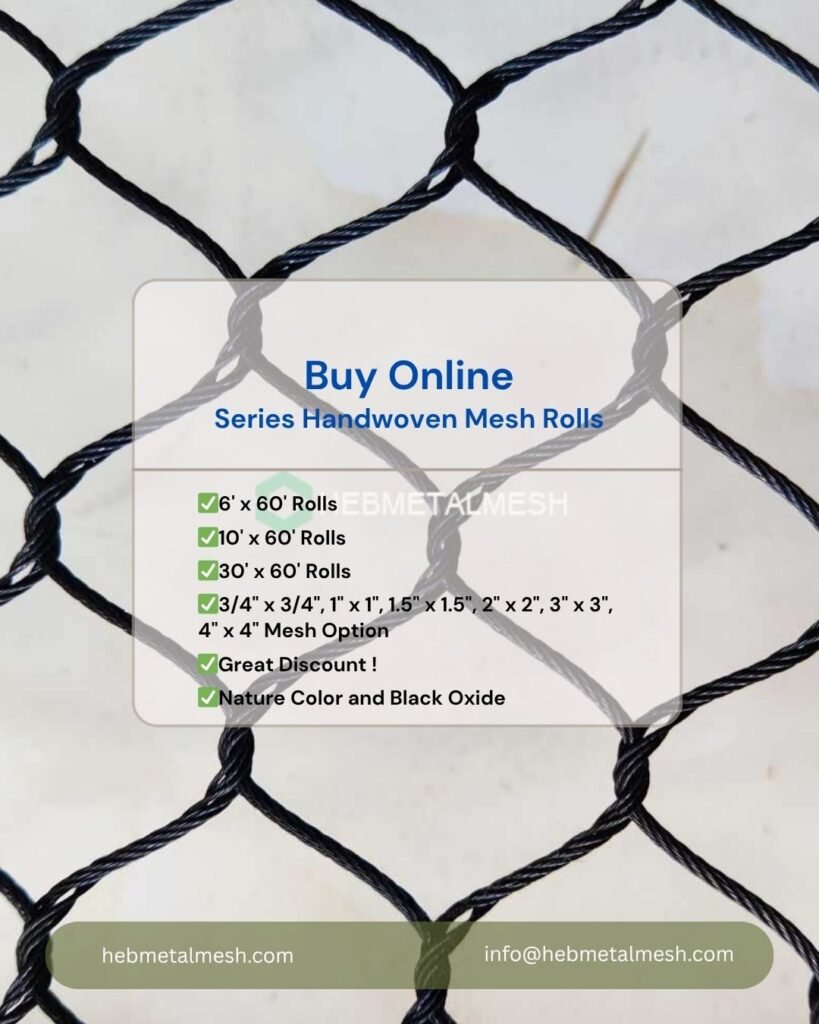
When it comes to acquiring high-quality animal netting, particularly handwoven stainless steel mesh, the market offers a variety of options that cater to distinct needs. Selecting the right supplier is essential for ensuring that the netting is durable, effective, and suited for the specific wildlife protection requirements you may have. One of the most reputable ways to purchase animal netting is through specialized retailers that focus on wildlife management and protection products. These suppliers often stock a range of netting options, allowing customers to compare materials, sizes, and prices. Additionally, knowledgeable staff can assist you in selecting the right type of netting based on your project or setting.
Online marketplaces have become increasingly popular for sourcing animal netting. Websites such as Amazon or eBay offer a variety of options, often featuring customer reviews that can guide your purchase decision. However, one must exercise caution and prioritize trusted brands with a proven track record of quality. Look for products specifically labeled as handwoven stainless steel mesh, as these will offer superior strength and protection compared to standard plastic or wire alternatives. Evaluating product specifications and the seller’s reputation is crucial in this context.
Aside from specialty retailers and online marketplaces, local garden and hardware stores also tend to carry animal netting products. Visiting these stores allows you to physically assess the material and gauge its suitability for your needs. Before making a purchase, consider asking about bulk options, as these can often lead to cost savings if you require a large amount of netting for extensive projects.
Ultimately, whether you choose to buy from a local store or an online retailer, ensuring the quality of the animal netting will provide the confidence needed to safeguard your property against unwanted wildlife intrusions.
FAQs
A: Our handwoven stainless steel mesh offers unparalleled durability and safety for long-term animal containment. Unlike plastic that becomes brittle or galvanized wire that rusts, stainless steel is inherently corrosion-resistant animal fencing, standing up to harsh weather, moisture, UV rays, and animal interaction (chewing, scratching, impact) for decades. It provides a predator-proof barrier that won’t degrade or weaken over time, offering superior protection for poultry runs, aviaries, or animal enclosures compared to temporary solutions.
A: Absolutely. Our stainless steel animal netting is designed with animal safety as a priority. The smooth, handwoven wires eliminate sharp edges or burrs found in some welded meshes, preventing cuts or abrasions. We offer various mesh sizes for different animal containment needs – smaller openings for chicken coop predator protection or keeping small pets secure, and larger openings for aviaries or larger enclosures where visibility and airflow are key. It’s non-toxic and won’t leach harmful chemicals.
A: Handwoven stainless steel mesh is the most durable animal fencing solution for permanent installations. The weaving process creates a flexible yet incredibly strong fabric that resists tearing or unraveling under stress. Its inherent rust-proof properties for outdoor animal netting ensure it withstands rain, snow, humidity, and coastal salt air without corroding. This makes it ideal for long-lasting animal barrier systems like secure aviary netting, reptile habitats, zoo exhibits, or perimeter fencing for gardens vulnerable to wildlife.
A: While the initial cost may be higher than some alternatives, our handwoven stainless steel animal netting represents significant long-term value. Consider it an investment in permanent animal enclosure solutions. You eliminate the recurring costs and labor of replacing degraded plastic netting or rusted wire every few years. Its exceptional predator-deterrent strength for livestock protection and decades-long lifespan make it the most cost-effective solution over time, especially for critical applications like protecting valuable poultry from foxes or raccoons.
A: Installing our heavy-duty stainless steel animal fencing is similar to installing other rigid mesh types but with greater longevity. It can be easily cut with tin snips (wear gloves!) and attached securely to robust frames (wood, metal posts) using staples, screws with washers, or specialized clips. Its flexibility allows it to conform to curves better than welded mesh. For ground-level applications like dig-resistant animal enclosure netting, burying a lip or using an apron prevents burrowing. We provide general guidance, and many DIY enthusiasts find it manageable for projects like building a predator-proof chicken coop.
A: Yes! A key advantage of our handwoven stainless steel mesh is its suitability for custom animal netting solutions. Whether you need a specific panel size for an odd-shaped aviary, a unique cut for a zoo exhibit, or specialized bespoke animal containment mesh for exotic pets, we can typically accommodate requests. Handwoven mesh is often more adaptable to custom shapes than rigid welded panels. Contact us directly to discuss your specific animal barrier requirements.
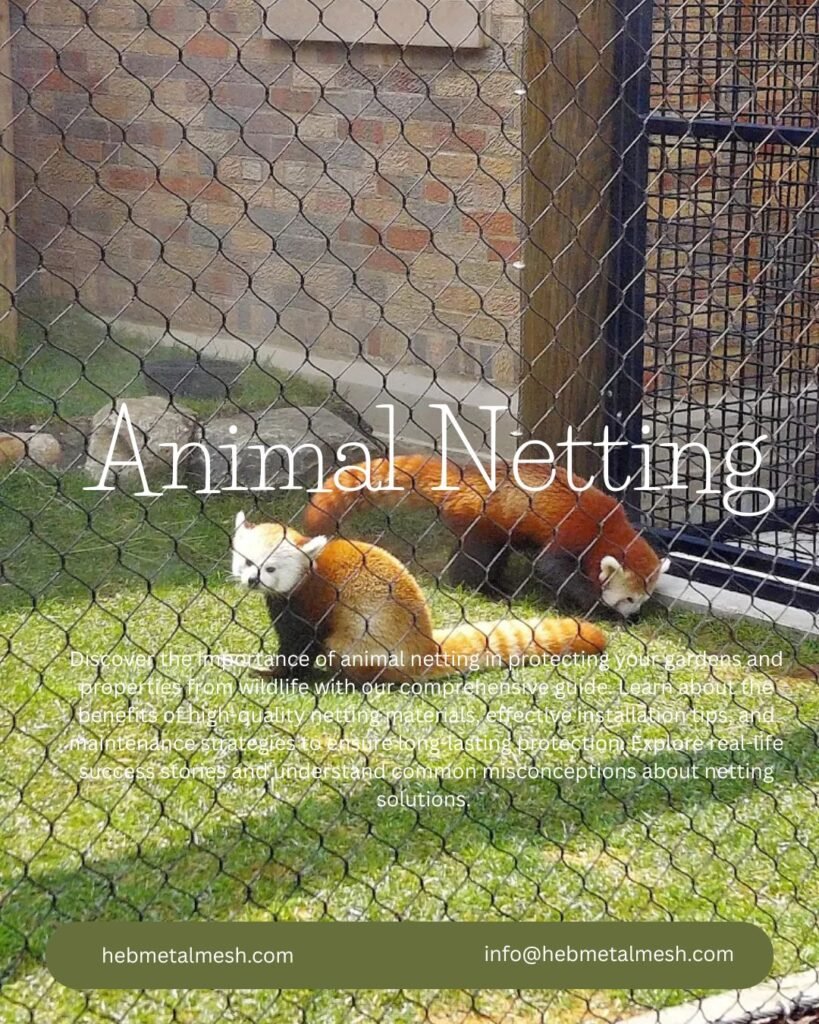
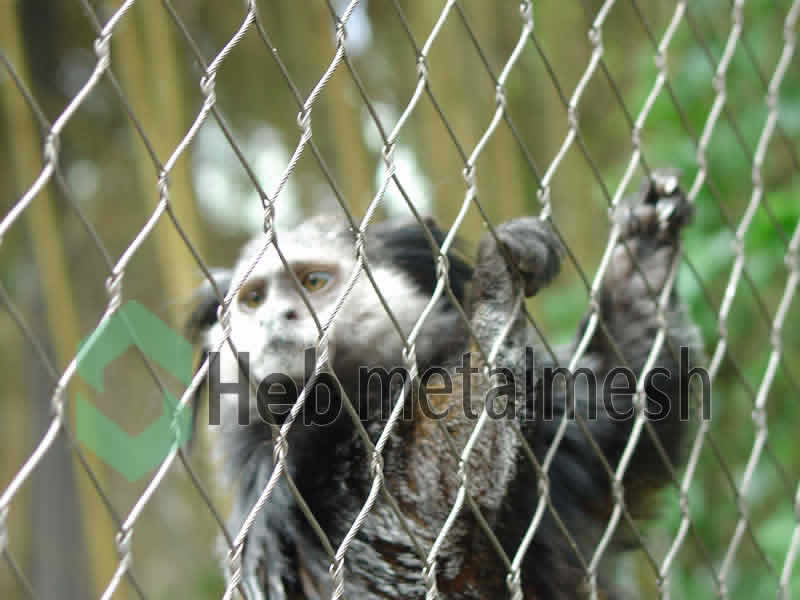
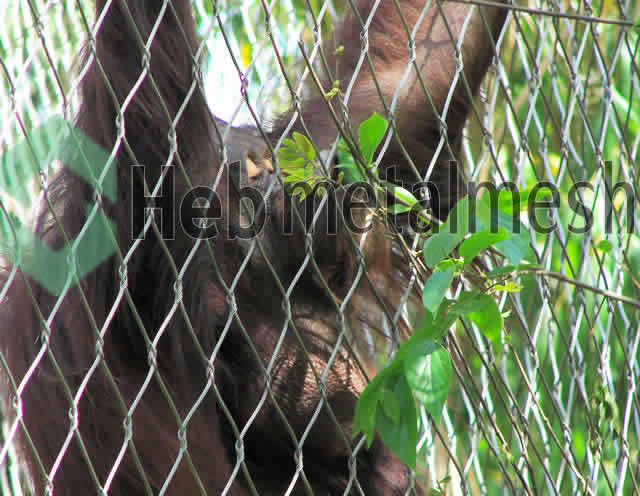
Pingback: How bird netting can prevent birds from destroying your garden - Top Shade Net Plastic Mesh and Bird Net Supplier | OMB Textiles